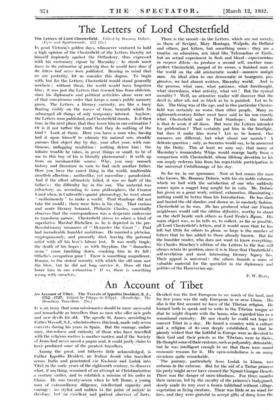An Account of Tibet ve is an irony that some
missionaries should be more successful add'remarkable as travellers than as men who offer rich gods and- new devils for old. The apostle St. James, acaOrding to Father Wessell, S.J., who introduces this book, made only seven converts during his years in Spain. But the courage; endur- ance„shrewdnes,s and curiosity Of those who have -Unveiled with the religious motive is another matter, and if the Society
of JeSus had never saved a pagan soul, it could justly claim to .
have produced some of the greatest travellers. .
• Among the great, and hitherto little acknowledged, is Father Ippolito Desideri, an Italian Jesuit who travelled across India and penetrated via Kashmir and Ladak into Tibetrin the early years of the eighteenth Century, to discover What,- if anything. remained of an attempt at Christianization a Century earlier, and to establish a mission of his order in LliiSa: Ile was twenty-seven when Ile left Romer a young Man of extraordinary diligence, intellectual capacity and courage ; do Stylist and Sodden _to „(lie point of natrifil in theology, but in et:CCIlerit add:patient : observer of facts. Desideri was the first European to see much of the land, and for five years was the only European in or near Lhasa. His also is the first account we have of the Tibetan religion. Ile learned both to speak and to write in the Tibetan tongue so that he might dispute with the lamas, who regarded hint as is sensational curiosity. He saw clearly he could not hope to convert Tibet in a day. He found a country with a culture and a religion of its own deeply established, so that he piously wished that the faithful in Europe were as devoted to their God and their priests as the Tibetans were to theirs. He thought some of their customs, spelt as polyandry, detestable, but he was intelligent enough to see that there were sound economic reasons for it. His open-mindedness is 00 many occasions quite remarkable.
• The journey, particularly from Ladak to Lhasa, was arduous in the extreme. But for the aid of a 'fartarprineess his party might never have crossed the Ngnari Giongar Desert. There was the danger of ,snow-blindness. For. three, months their caravan, led by the cavalry of the princess's bodyguard, slowly made its way .over a frozen tahleland without village, vegetation or living creature. There was little or no wood for fires, and they were grateful to accept ,gifts of dung front the
princess for fuel. She treated. them with pity and considera- tion, inviting them to her tent for warmth, sending them gifts of food, making one of her officers give up his horse to DeSided when his own went lame. With concave masks Woven out of horsehair to protect their eyes, and dressed in lambskin which kept out the violent winds but housed innu- inerable insects, Desideri's party struggled over the steep and icy tracks. Of their seven horses, only two reached Lhasa alive.
Desideri's reception in Lhasa AVON excellent. Rut the King Was at the mercy of the Chief Lama. the monasteries were humming with intrigue, and when the Tartars fell upon the city and mindered the Royal Family it was with the connivance of part of the populace. Desideri, who had been Making great Progress with the tolerant king, had to flee to a Tibetan monastery eight days' journey away, and remain there most of the time during the next four years. At last his hopes were finally iiestroyed by instructions from Rome to leave the country to the Capuchins, who claimed priority.
While Desideri's description of Tibetan customs is fascinat- ing and has an importance of which later travellers have, according to the editor, been ignorant (he was, for example, the first in his time to identify the Tsang-po river with the Brah- maputra) he is at his best in describing the Tibetan religion and its myths. Later writers have mentioned the almost Darwinian legend that Tibet was populated by a lost W01111111 who had children by a monkey. Equally remarkable is the resemblance to the story of Prometheus chained to the Caucasus, in the tradition that the shape of Tibet is that of a female demon lying on her back pinned down by monasteries built on her arms, hands, legs, feet. Desideri proceeds to a thorough if horrified account of the belief that the Dalai Lama is the god ('en-nee-Zig, taking voluntarily and con- tinuously human form to save men's souk The similarity to Christian belief made him unpleasantly aivare of the workings of the devil. The .Tibetaris readily agreed upon the proba- bility of fraud but politely refused to believe that this was the Christian devil's doing.
Putting aside a slight error in the numbering of the notes in the appendix to the first volume, the editing of this book is admirable in its thoroughness and learning. It is a pleasure to turn from the narrative and consult this informative com- mentary. Desideri himself is so completely self-effacing that his character is seen only by implication. One could have wished that his self-abnegation had not ,been so thorough. his narrative would have been richer if there had been more of hint, for he was clearly a delightful person. His book will take its place among the classics of travel literature. It appears' in English for the first tine since the discovery of the original MS. inever fifty years ago.
V. S. Mount:Tr.



















































 Previous page
Previous page